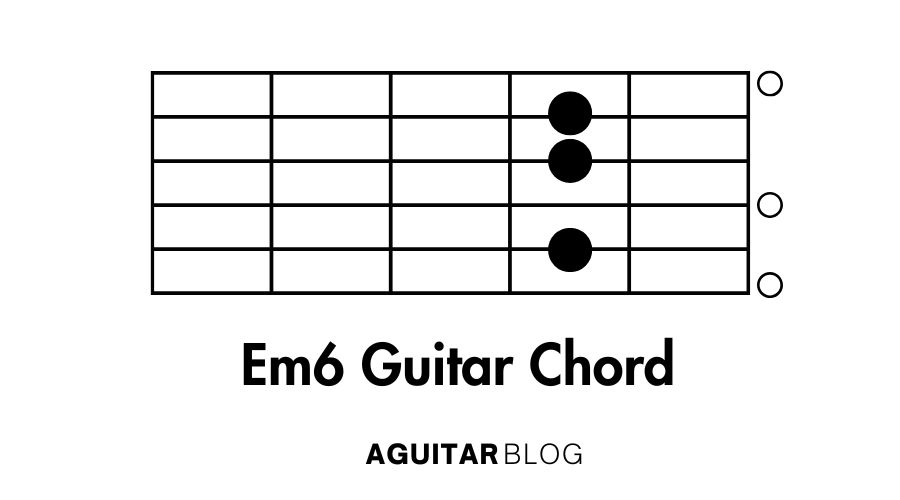The Em6 guitar chord (E minor sixth) is an interesting and versatile chord that adds a jazzy or melancholic flavor to your playing. It combines the standard E minor triad with the addition of a sixth note, creating a chord that’s often used in jazz, blues, and even some folk or pop music. In this guide, we’ll cover what the Em6 chord is, how to play it, common mistakes, and tips to help you master this beautiful chord.
1. What is an Em6 Guitar Chord?
The Em6 chord is a minor chord that adds the sixth note from the E minor scale. It blends the darker, sadder sound of E minor with a slightly brighter, more hopeful tone provided by the sixth.
Em6 Chord Formula:
- Root (E)
- Minor third (G)
- Perfect fifth (B)
- Major sixth (C#)
The combination of these notes gives the Em6 chord a unique, somewhat jazzy feel, with a balance of both melancholy and brightness.
2. How to Play the Em6 Guitar Chord

Here are a few common ways to play the Em6 chord on the guitar:
Em6 Open Position (Beginner-Friendly):
- Place your middle finger on the 2nd fret of the D string (4th string).
- Place your index finger on the 1st fret of the B string (2nd string).
- Strum all six strings, allowing the open E, G, and high E strings to ring out.
This open position version of the Em6 chord is the easiest to play and gives a rich, full sound.
Em6 Barre Chord (7th Fret):
- Barre your index finger across all strings on the 7th fret.
- Place your ring finger on the 9th fret of the D string (4th string).
- Place your pinky finger on the 9th fret of the B string (2nd string).
- Strum all six strings, focusing on clarity in each note.
This barre chord version is more advanced, but it provides a tighter, more controlled sound.
Strumming Tips:
- The open version works well for softer, more melodic playing, while the barre version is excellent for louder, punchier rhythms.
- Use fingerpicking to highlight the chord’s intricate harmonic structure.
3. Video Tutorial
For a visual guide on how to play the Em6 chord, check out this Video Tutorial on the Em6 Chord. It covers different versions and playing techniques.
4. Common Mistakes and Tips for Playing the Em6 Guitar Chord
Common Mistakes:
- Muted strings: Ensure that your fingers are positioned properly so that all strings ring out clearly, especially in the open version.
- Weak barre strength: In the barre chord version, press down firmly to avoid muted or buzzing strings.
- Finger positioning issues: Make sure your fingers are placed precisely on the fretboard to avoid accidental muting or buzzing.
Tips for Playing the Em6 Chord:
- Practice transitions: Move between Em6 and other chords like Em, G, or Am smoothly to improve your fluidity.
- Start slow: Play the chord slowly at first to ensure every note rings out clearly, especially in the barre version.
- Experiment with dynamics: Play softly or use fingerpicking to bring out the delicate harmonics of the chord.
5. Em6 Chord Variations
Here are some variations of the Em6 chord:
- Em6 Barre Chord (12th Fret): You can also play Em6 as a barre chord higher up the neck for a brighter, more distinct sound.
- Em9: Add the ninth (F#) to the chord to create a more complex, jazzier sound.
6. Chord Progressions and Songs Featuring the Em6 Guitar Chord
Common Chord Progressions:
- Em6 – Am7 – D7 – G: A jazzy progression that uses Em6 to add sophistication.
- Em6 – A7 – Dmaj7: A progression that uses Em6 to transition smoothly between major and minor chords.
- Em6 – Gmaj7 – Cadd9 – D: A modern pop/folk progression that incorporates Em6 for depth.
Songs Featuring the Em6 Chord:
- “Summertime” by George Gershwin: Features Em6 in its classic jazz/blues progression.
- “Blue Monk” by Thelonious Monk: Uses Em6 in jazz progressions to add a bluesy feel.
- “Stairway to Heaven” by Led Zeppelin: The Em6 chord can be heard in the song’s intricate acoustic parts.
7. Tips for Practicing the Em6 Guitar Chord
- Slow practice: Start by practicing the chord at a slow tempo to master the finger placement and transitions.
- Use a metronome: Keeping time with a metronome can help you get the chord changes down smoothly.
- Explore fingerpicking: The Em6 chord sounds great when fingerpicked, especially in slower, more melodic pieces.
8. Related Chords to Em6 Guitar Chord
Here are some related chords that pair well with the Em6 chord:
- Gmaj7: A major seventh chord that complements Em6 beautifully in jazz or ballad progressions.
- Am7: Another minor chord that pairs well with Em6 in jazz, blues, or pop.
- D7: A dominant seventh chord that often follows Em6 in blues or jazz progressions.
The Em6 guitar chord is a wonderful chord to add to your repertoire, offering a blend of melancholic and jazzy tones. Whether you’re strumming it in an open position or playing a barre chord version, mastering the Em6 will unlock new harmonic possibilities in your playing. Enjoy experimenting with its unique sound!